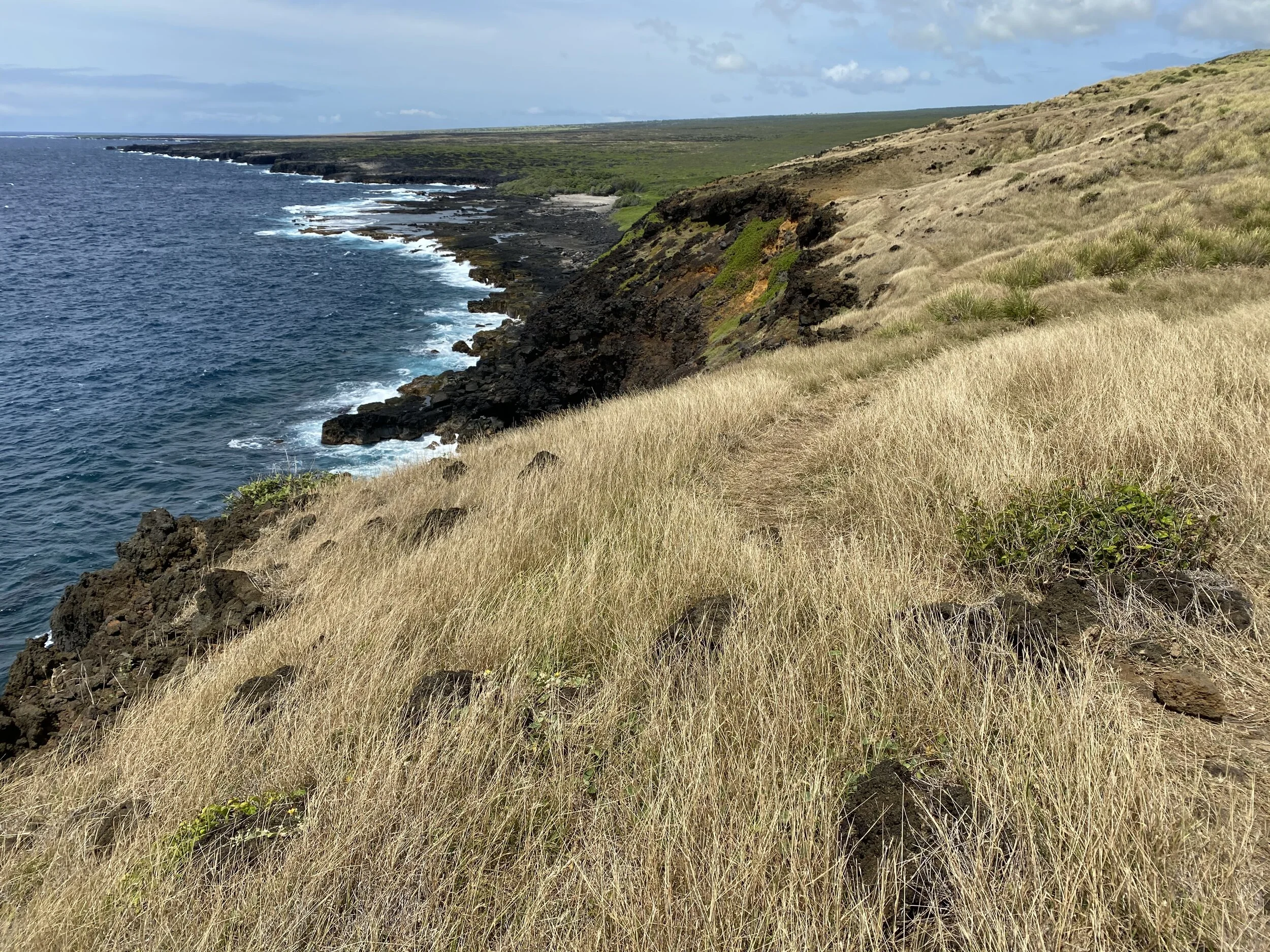Manakaʻa
Coastal lands of Manakaʻa, Kaʻū
Manaka‘a Fishing Village is a 348 acre undeveloped coastal parcel in the ahupua‘a of Kāwala famed for the Maniania Pali sea cliffs. These coastal lands below Na‘alehu have long been cherished by the Ka‘u community for subsistence fishing, cattle ranching, and precious cultural sites (heiau, burials, ahu, lava tubes, underground springs, and ancient house sites).
The Ka‘u community, Ala Kahakai Trail Association, and The Trust for Public Land are working together to protect Manāka‘a from development and preserve this storied coastline so future generations can walk in the footsteps of their ancestors.
Kuahiwi Ranch, owned and operated for three generations by the Galimba ‘ohana leases these lands, rich with Pahala Ash soil, for cattle ranching, producing free-range grass-fed beef, contributing to a sustainable local food system, and perpetuating Ka‘ū’s paniolo culture.
A rich historical and Cultural Landscape
Maniania Pali, Manakaʻa, Kaʻū
The lands along the Maniania Pali are a rich historic and cultural resource for the Ka‘ū community. Its protection would preserve precious cultural sites, including heiau, caves which provide shelter for ancestral iwi kupuna, lava tube habitation sites, water collection caves with underground springs, ancient habitation complexes, ahu (altar) dedicated to Kua the shark god of Ka‘ū, and Manāka‘a Fishing Village which stands on the sea cliff over Waikapuna Bay.
“On the back of the Maniania Pali (giddy cliff)
Niu-loa-hiki lived. This tall coconut tree was one
form of the god Ku-Hina. Ku’s wife, Hina,
wanted to send her son to Kahiki (Tahiti) so the
boy climbed the coconut tree and sat in the top.
The tree grew taller and taller and the boy looked
down and felt giddy. The tree continued to grow
and grow until it bent down and touched Kahiki,
and the boy arrived there safe and sound.”
A network of ancient trails that unite mauka (mountain side) and makai (ocean side), traverse through Manāka‘a providing vital links between farming and cultural sites in the mountains and fishing and housing sites along the coast. Together these sites along with their rich history constitute the cultural landscape of Manāka‘a, an important part of Ka‘ū heritage.
Connecting to the past by connecting communities of present
Manākaʻa means, “a ball of chewed ʻawa root.” In the sea close to the shore of Manāka‘a is Pōhaku o Kua, a great stone on which ‘awa and bananas were offered by fishermen to Kua, the shark god of Ka‘ū who came from Kahiki.
Protecting Manāka‘a from development would ensure continued access to this coastline, important for a community which still relies on subsistence fishing, farming and gathering. Conserving this coast will perpetuate cultural access for descendants and recreational access for travelers along the ancient ala loa (Ala Kahakai Trail) allowing all to walk in the footsteps of Ka‘ū’s ancestors.
The Unskilled Fishermen at the Sea of Manaka’a
“KA-LAWAI‘A-HŌLONA-I-KE-KAI-O-MANĀKA‘A”
This is a name chant for Kalawaiʻahōlonaikekaiomanākaʻa, who was born in 1854. She was known as Holona for short. It tells of the story of Ke-li'i-kanaka-'ole-o-Haililani, Kawena Pūku‘i's grandfather, his younger brother, Ke-kipi-o-Haililani and their cousin, Kawelu who went fishing in the sea of Manāka‘a (at the eastern end of Waikapuna and outside of Kawaiuhu.)
Keawe-hano was a noted fisherman, referred to as "the quick one“. He made fun of them and called them the unskilled fishermen of Manāka‘a. Kanaka‘ole, who was a noted kahuna la‘au lapa‘au (medicinal kahuna) and kahuna ho‘oului‘a (expert on fish habits), began to offer prayers to a female ‘aumakua who lived in the sea. It was said that she answered his prayers by giving him quantities of fish which he caught for his chief, Alakaihu-i-ke-Kupa‘ai. When the first great haul of fish was caught at Manāka'a, Keawe-hano forgot his unkind words and in his excitement, ran to help so that he might be given some.
Soon after, Huli-o-ka-manomano, the wife of Kawelu, gave birth to a little girl. This was her name chant and she was named Kalawai‘ahōlonaikekaiamanāka'a.
Years later, after this little girl had grown up and married, she gave birth to a stillborn baby. Kanaka‘ole placed the child in a large calabash, held the clabash up to catch the warmth of the sun, and prayed that she would live. The baby stirred and cried and it was Kanaka‘ole who named her, "Hanau-maka-o-Kalani" (Kalani who was born from an eye), for a shark ‘aumakua who was born from his mother's eye.
conservation funding
In 2021, The Trust for Public Land (TPL) and Ala Kahakai Trail Association (ATA) applied for and received a grant from a private philanthropic foundation to allow ATA to acquire a Conservation Easement over the property. This easement will keep the land in agriculture and protect its cultural and natural resources including the trail system. The new landowner has conveyed a conservation easement to ATA in order to protect the property’s agricultural, cultural, and natural resources in perpetuity.






